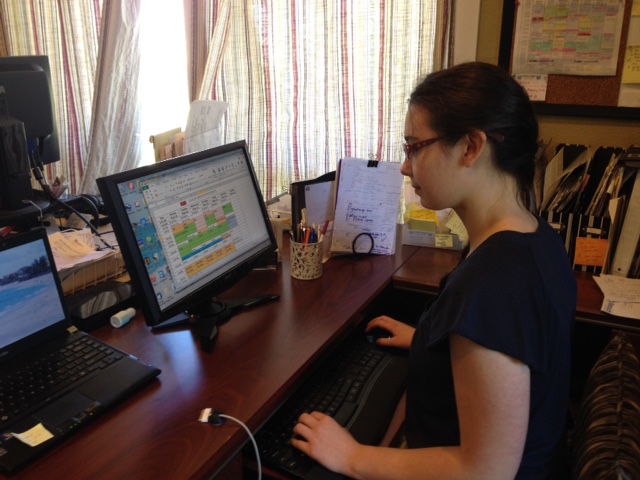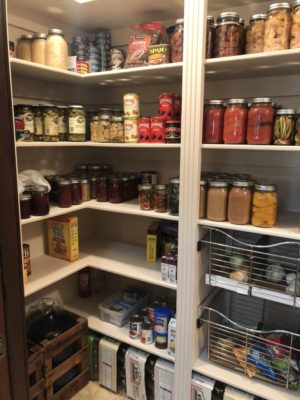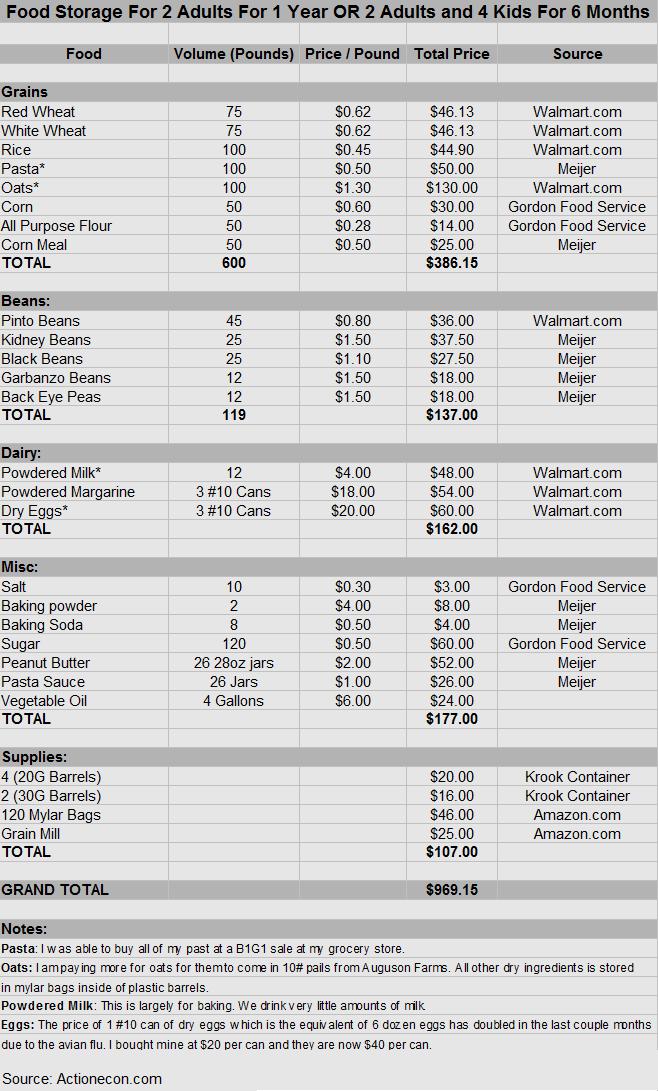Has setting up your home office during COVID-19 virus been a headache? If productivity has been an issue for you, I’ll share some organizing and time management hacks that will make a huge impact on your work.
What people working at home don’t realize: everyone has an inner productivity circle.
In fact, if you think about your home office as a series of circles radiating away from you (like the parallel ripples that radiate out when you drop a rock into a still pool of water), you’ll realize that what you keep close to you is important.

I first learned about this concept from my organizing mentor, Porter Knight. She talks about it in her book, Organized to Last. In it, she coined the term ‘concentric circles’.
I recently taught this productivity principle at a lunch and learn for a large local company. Several people were blown away by this principle; the idea that your work output increases when you only keep frequently used items within arms’ reach.
It makes total sense to me, if you spend less time getting up to use tools in the office, your workday will be more efficient. I will illustrate.
Circle 1: For me, the tools I use every day several times a day need to be in my inmost work circle of my home office. I should not have to roll my chair or even swivel it to get the items I use more than twice a day.
Items in my inner productivity circle: computer, mouse, planner or to-do list, pens, Post-its, stapler, tape, tool drawer, timer, hand lotion, drawer of important files, and trash can.
You may need additional tools like a 10-key, calculator, or specialized items for the work you do.
Circle 2: The next layer for efficient work at home would contain tools and resources you might use once a day. For example: file drawers, your tissue box, projects file, business card binder, cork board or whiteboard, speakers, etc.

Circle 3: The Third layer, the one farthest from you, would have things like resource books, archived files, office supply storage, camera equipment, supplies you travel to clients with, a briefcase or bag for networking events, etc. This layer holds supplies or archives used occasionally or rarely.
When I work with a client, we concentrate on creating open space around them in their home office, The problem with most work spaces is they have TOO MUCH STUFF cluttering their inner circle. this is true for many who are working at home.
Stuff that clutters up our desks: papers that need to be filed, projects, ideas, mail, Post-its, business cards, books, food, and personal items unrelated to your work or comfort are some of the clutter.
Did you know that clutter actually distracts from your work? Visual clutter, like stacks of paper, magazines, or too much in your inbox contribute to a state of low-level anxiety for some people.
Watch what happens when you clear off all the clutter from your desk and floor in your home office. I know every time I put all my papers away in files or project binders, I feel a rush of energy and am motivated to tackle the most important task of the day. Try it, you’ll like it!
Some people I’ve worked with are comfortable with one pile of work on their desk or a large inbox, and that’s fine. The important thing is to find what works best for you.
To help you even more, I’ll share a list of tips for staying productive while working at home. Time management tips like these are sorely needed in these unprecedented times when all the kids are home attending virtual classes because of COVID.
Figure out what your best focus time is. Do the work that requires the most brainpower then. If you’d like to pinpoint the time of day, email me and I will send you a quiz that will show you when you do your best work! jennym@efficientspacesco.com
If your spouse or kids are home during work hours, make sure they know not to disturb you. Close the doors if you need to. Put on headphones with some music that helps you focus. This has a dual job: to let people know you don’t want to be disturbed, and it keeps you from hearing background noise.
“Ambient sounds, especially with words, occupy about 5-10% of your intellectual bandwidth. By wearing ear protectors, you acoustically isolate yourself. This freed up bandwidth can now be focused on the desired task.
It’s a great deal. Just put on some earmuffs and you become 5-10% smarter.”
~ Peter Rogers, Straight A Stanford and on to Harvard
To be effective, make a plan for your week and then break it down by the day. I I start out with a ‘dump list’ then transfer the tasks to my planner, which uses a funnel-down system to help me choose which day to put each task. I use my planner for my to-do list, but a notebook or a sticky note works well to identify the most important daily tasks. For most people, having a daily purpose is a huge motivator. It’s satisfying to check those items off when they’re finished! I would be lost without my to do list. Most professionals who excel at time management use some form of a to-do list, whether electronic or paper. *I use the Planner Pad Organizer.
With emails, you can take one of 3 actions: File, respond, or delete. Try not to think about it too much! It doesn’t have to be complicated. The general rule of thumb: if it takes 2 minutes, do it now. (From Getting Things Done by David Allen)
Also, have folders for emails or email categories. Organize them by topic, project, or individual names. A person wastes 6 weeks annually searching for lost documents or because of unorganized folders for the one project they need. Be consistent about filing them. It helps so much when you need that information later!
Have an inbox for paper, and clear it daily.
Have a “hot spot” for today’s most urgent project. Personally, I prefer a clear file folder standing up in a vertical file sorter. My home office file sorter holds 5 files. Also, put your to-do list in plain sight and review it each morning before you start.
Definitely prioritize projects based on their ROI and on the deadline or due date!
If you tend to distract yourself: ahem… yes I do that! I find that setting a timer is very helpful. This works well if you are easily distracted by “bright and shiny” new emails. Say your purpose for opening your email is to write one necessary email and then close the email so you can focus on a project. Set a timer for 15 minutes before you open your inbox to avoid getting “sucked in” by your email. This really works! (I keep my timer within arm’s reach in my home office.)
“One way to boost our will power and focus is to manage our distractions instead of letting them manage us.” ~ Daniel Goleman
If texts, incoming emails, Zoom pop-up, or calendar notifications have alerts that distract you when you are trying to focus in your home office, make sure to turn off those alerts for the hour or 90 minutes when your project needs your full attention. (Before you do this, check your calendar to make sure you don’t have a meeting or scheduled phone call.) If you are not sure how to do this, ask a tech-savvy friends! Or link to the article I provide at the end of this post.
Delegate email deletion and unsubscribing from sites to your kids or grandkids (it works great!). Also, make sure to limit spam by having good firewalls in place to limit what gets to your inbox.

For information you want or need to keep, have it scanned by someone you can delegate to (an assistant, tech-savvy son/daughter, grandchild, high school student) and file or organize it into files. Make sure and have the helpers to do it at a time when you’re doing something low-focus, like responding to emails. That way the interruptions with questions won’t affect your productivity in your home office.
Use these 10 tips to achieve more and reach your business goals!
Related posts: 5 ways to keep distractions at bay: https://efficientspacesco.c.wpstage.net/2015/02/5-tips-distractions-bay/
New Habits: you can do anything for 30 minutes: https://efficientspacesco.c.wpstage.net/2014/05/30-minutes/
How to get an extra hour of productivity daily: https://efficientspacesco.c.wpstage.net/2014/02/extra-hour/
How to turn off distracting notifications: http://www.makeuseof.com/tag/5-distracting-desktop-notifications-turn-windows/
5 Food Storage Basics
The point of food storage is to have food storage in place BEFORE an emergency strikes.
I just made a trip to a warehouse (owned by my church) to purchase a bunch of staples like flour, sugar, wheat, salt, etc. Back in February, I had the thought: I need to beef up our food storage! Organizing your food storage is so important for peace of mind when disaster strikes.

The reason: partly inspiration, partly because we had used a lot of flour and sugar last December. My son Jacob and I had baked and sold cookies to raise money for a school trip. So, I thought we were running low. (Turns out, we still had enough flour for 6 months in our storage.)
That brings me to the first step in organizing your food storage.
Have you ever gone to the grocery store and bought ketchup because you thought you were almost out, only to find you have 3 bottles of ketchup in your pantry?

It’s crucial to know what you already have stored. Not taking an inventory before you go to the store or get online leads to waste, because your family won’t be able to consume it before it spoils.
On the other hand, when you DO take an inventory of how much flour, sugar, yeast, oil, milk powder, salt, etc. you have stored, you won’t end up with waaay too much of one item. Or too little of another staple food. You might be surprised how fast you’ve used up the flour, for example.
Here’s what I do when I purchase food to put in storage: I put the date of purchase on the container. It’s helpful to keep records and to inventory your storage at least once a year.
If you want to know how fast your family uses up 10 pounds of flour, for example, there is an easy way to figure that out. Simply label the container with an “open date,” which is the date you started consuming the flour. A piece of masking tape or white duct tape works well.
Then, when you use the last of it, note the date on the tape. It’s a great trick. Just make sure to plan for extra usage during holidays like Christmas, when you’ll do a lot more baking.
What do you still need to “round out” your food storage? Do you have everything you need to make bread, for example? What about soup? How many different meals could you make with the food you already have on hand? If you only have the ingredients for 3 different meals during an emergency, you will get mighty tired of eating those 3 meals!

One thing we like to do for variety: purchase hiking meals and MREs. It provides us great choices without having to purchase a bunch of perishable ingredients for our food storage. And they last about 10 years! They are packaged in a pouch and quite light, especially the hiking meals. Everything you need to cook the meal is inside. Super efficient!

Being prepared will save you from fear, because you will rest easy knowing you have enough food, water and fuel to provide for your family.

I have not worried about food, or even toilet paper, since this pandemic struck the world. Why? Because I had prepared for a disaster. I was surprised it came this soon, but that didn’t matter. The essential matter is to be ready for anything.
If an emergency like the Covid-19 virus comes around again, plan for married children returning home to wait it out with you. Currently, we have 2 adult children home with us, plus one teenager. And we have plenty because we have enough food storage to feed 5 people that will last 6 months.
Definitely plan for the worst-case scenario. Purchase the food that will fill in your gaps. You can do this bit by bit, purchasing some supplies every month. Or you can buy it all at once.
You saw what happened during the COVID-19 scare when everyone tried to get their food storage at the same time. It’s chaotic and a bit scary. Stores started running out of many items like toilet paper, paper towels, bleach, flour, sugar, survival foods and foods with a long shelf-life.
Q: When is the time to get your food storage together?
A: Gather food storage BEFORE disaster strikes—not after!
President Gordon B. Hinckley, “If ye are Prepared ye Shall Not Fear,” Oct. 2005.
*Doctrine and Covenants 109:8 https://www.churchofjesuschrist.org/study/scriptures/dc-testament/dc/109.8?lang=eng#p8 D&C 109:8
**Doctrine and Covenants 38:30, https://www.churchofjesuschrist.org/study/scriptures/dc-testament/dc/38?lang=eng
Providentliving.org: https://providentliving.churchofjesuschrist.org/?lang=eng
Building a 6-month Food Storage Supply (with table listing foods and amounts) https://actionecon.com/building-a-6-month-food-storage-supply/
1 Year food Supply for a Family of 4 http://seasonedcitizenprepper.com/feed-a-family-of-4-for-1-year-for-less-than-300/
This is the BIG question everyone wants to know: how much does hiring an organizer cost, anyway? Do I have to be wealthy to get organized? Here’s some tips and tricks!

That very much depends on the size of the project, how fast the organizer is, how quickly you make decisions, and the amount of clutter and backlog in your home or office.
A new organizer may charge a lower hourly rate because she (and it’s almost always a she) doesn’t have much experience, so you’ll pay less per hour. For example, a 10-hour job may cost $500. A more experienced organizer will charge more and get the work done faster. She has thousands of hours of experience. Therefore, you might pay between $750 and $1000 for 10 hours of organizing. In large metropolitan areas, the organizing cost will be higher.
Also, most organizers give a discount for a package of hours, which is paid for after the initial meeting (the assessment). Most organizers give a 5 to 10 percent discount for paying up front, either at or before the first organizing session. This could save you hundreds of dollars in organizing cost over the life of the project. Link to similar article here.
Here’s a suggestion: do a cost/benefit analysis to see if a less experienced organizer is worth the savings. If your time is valuable, weigh the benefit of hiring a faster, more experienced organizer versus a slower, less experienced one. Since time is money, and money well spent saves time, the organizing cost is worth it.
When you ask a lawyer how much money it will cost to win your case, he doesn’t know because he cannot predict the research, how long the case will take, etc. Likewise, a professional organizer will not be able to tell you how long your project will take until she has finished the assessment and done at least 1 work session with you. This is not because she is inexperienced. A lot of variables come into play to determine the length of work: her speed, your decision-making speed, how much clutter you have to work through, and the level of organization you desire. Similar to presenting a court case, organizing is a process of preparing, making a plan, and working through all the clutter in your home and in your brain.
Organizing is a process, not a one-time event. As any professional organizer will tell you, she is often a coach as well as an organizer. She coaches you through the often-difficult process of letting go. Therefore, the number of hours she states as an estimate is just that—an estimate. Think about it this way: you wouldn’t say to your therapist—I’m only going to work with you for 10 hours, even if my PTSD isn’t fixed. S/he wouldn’t agree to see you as a patient.
Now apply that to organizing; if your project isn’t finished, the work with the organizer is not done either. The process of getting organized is logical. It is a multi-step project based on a proven method and an orderly completion of all the steps. So, if you skip a step, you sabotage the results. Complete the steps and you complete the project. And you have a lasting result. For tips on hiring an organizer, click here.
First, the pay-as-you-go option. In this model, you pay for each session at the time of service. This is easier to budget for because it will be a certain amount per week or per month. Also, the organizer cost will be full price; no discounts.

Second is the package option. In this model, you pay up front for a set number of hours. This requires a larger initial investment and commitment. The organizer will usually give you up to a 20 percent discount. As you can see, the package discount makes the professional organizer cost more doable.
An organizer prefers to sell a package because she knows a client is more likely to finish the project when they have paid for the whole package. It shows a level of commitment to finish. With the pay-as-you-go model, distractions or other monthly expenses may crowd out the organizing goal. Often, this is the case.
Keep in mind the reason organizers do what they do is because they like to help people. She is not in this profession because she wants to get rich. She is service minded and loves to see you successfully reach your goals for organization. You know the thrill you get when you serve someone who really needs it? Well, that how your personal organizer feels when she helps you improve your life. Especially if you tell her just how powerful an impact getting organized has had for you.
Most organizers, in the first meeting or intake, will ask what your budget is for the project. If you don’t know, she will share her rates with you and you decide the speed which you’d like to see results. Personally, I work with people’s budgets and have been known to give discounts to those who truly have limited resources.
When setting a budget, keep in mind the cost of not getting organized. What is the emotional and productivity cost of being disorganized? How much do you pay for storage units per month? How many bills have you missed due to lack of a system, which incurred late fees? Or, how many duplicate tools or other items have you purchased because you cannot find the one (or two) you already have somewhere? When you think about the cost in this light, the organizing cost is a bargain. Link to How Organizing saves you Money here.
Recently, a new client came to me, eager for my expertise. She told me she had read in an article that the cost of hiring a professional organizer is worth every penny. I agree. Link to article here
Need help? Contact me! I provide a free 30-minute exploratory call.
How Organizing saves you Money: Read Article
Want to be happy? Buy more takeout and hire a maid: Read Article
Reasons to hire a professional organizer from NAPO NJ: Read Article
5 Tips for Hiring a Professional Organizer: Read Article
3 Surprising things I learned from Hiring a Professional Organizer: Read Article

This is one time when advertising in your local paper pays off. Broadcast your event on FB too. You can create an event and invite friends.
To avoid having to tag everything, have a$1 box, a $5 table, a $10 table, etc. Larger items need to be tagged. Also, don’t forget to comb the house for items to sell, especially the kitchen and kids’ rooms.
Find a friend or two who have stuff to sell. Big items like furniture tend to draw “drive-by” buyers. Put large items out in the driveway or on the lawn to draw in customers.
Be flexible: If someone offers less than you were hoping for an item, be willing to entertain that offer. Make a counter offer that’s higher, and you will find most people will meet you in the middle.
“Dishes, cookware, kitchen gadgets are at the top of buyers’ lists.
Other popular items: toys and kids’ gear (strollers, playpens), artwork and frames, tools, lamps, and furniture (don’t rule out pieces with a few nicks or chips).
Anything high-end with a searchable name (like Venetian Glass). Use Ebay for trinkets that are easy to ship like jewelry, gold coins, comics. Use Craigslist or FB marketplace for heavy or large items so buyers will be responsible for pickup.
In order to go this route, be patient. I just ended up selling most of the tools from a client’s yard sale that happened 6 months ago. We got a good price, but they took up space in my garage for most of that time.
Be Realistic: If you know you’ll never get around to selling online, you’re better off purging stuff at the yard sale, though you probably won’t make as much as you would through a resale site.
Resources:
Too much to do is a common problem for today’s working women and men, especially those involved in management and knowledge occupations. Time management is crucial for these professionals! (Examples of knowledge occupations: Managers, Programmers, architects, CEOs, healthcare & support, and so on.)

If having too much on your plate is getting discouraging or frustrating, trying a few time management strategies I explore in the article will provide relief.
I worked with a company and the 2 top administrators, a man and a woman, both felt overwhelmed by all the tasks on their plates. I posed a few exploratory questions to ’Jake’ and learned his schedule was completely overbooked.
“How about delegating some of your tasks to other people here?” I asked.
In this case, both admins said No, it would not be appropriate to delegate several of his responsibilities to others in the company. They felt those people already had enough on their plates.
So, what is left? Any other strategies we can try for someone with too much on their plate?
Well, like Mom always said, you’ve got to clean your plate! And I mean that literally.
It’s time to create some white space.
It’s important to recognize, no matter who you are or what your job is, that things will come up during the day and you need to plan room for them in your schedule.
The only way to do this is by creating white space into every day.
And the way that works best is if you have a good handle on how long your planned goals for the day will take. That leads us to the first way to reduce stress: Planning.
Many time coaches call this time estimating. It’s something I teach in my time management seminar and in private time coaching sessions. A simple but effective concept, which you can do by timing how long different, often repeated tasks take you. Like creating an agenda for an upcoming staff meeting, calls to clients, following up on a lead, or tracking numbers for last week, for example.
How will time estimating help you be realistic about what you can accomplish in a day?
How will this, in turn, decrease stress?
It is helpful to track how much time each day the interruptions and crises take. Try tracking these for a week or two, then average it. While you’re at it, observe what time of day have the most interruptions. Then you can plan for these disruptions and a lot of the guesswork will be gone. You’ll have a good idea how many interruptions come and also, what time of day they tend to happen.
Can you see how this would be helpful to you? Try this strategy of actually scheduling enough unstructured hours into your day so that when emergencies come up, you already have time planned and can take it all in stride.
I guarantee your level of stress will decrease!
And one other thing you may be wondering: what happens if I don’t get the amount of interruptions I planned for? This is a good situation to be in!
In that case, planning a list of other things you’d LIKE to get done that week would be handy. I call this an opportunity list.
We all know there is no shortage of things to do. That’s why you’re reading this, yes? So, here’s a challenge for you: Start adding more white space to your day; at first, add 30 minutes, then an hour. Gradually increase it. Remember white space does not have to be one block of hours, you can disperse it throughout the day.
Let me know how this helped you! Once you’ve tried these strategies, reach out to me on FB or Instagram.
Or comment below. Thanks!
RESOURCES: https://jkglei.com/white-space/ Why you need white space in your daily routine by Jocelyn Glei
If you’re thinking about cleaning out the garage this summer you’re not alone. I’ve got some helpful tips for you, as well as some ideas for how to organize the stuff you want to sell as you go, to keep it really efficient and as quick and painless as possible. The mantra “touch it once” applies in garages too!
I’ve been thinking a lot about productivity this month. Multi-tasking has been on my mind; I am not a fan.

Multi-tasking, to me, means doing two activities at the same time, or alternating between them in short succession, back and forth, back and forth.
In fact, the other day I took a phone call while cooking dinner and talking to my 14-year-old son. Sound familiar? I bet it does. No one got my full attention, and dinner took longer. I’m sure my son didn’t feel heard, either.
I tend to multi-task in the office too. Sometimes it works; most of the time it doesn’t.
Two pertinent questions to ask before you multi-task: Will multi-tasking actually save me time here? Or will it divide my focus and cause my work to suffer?
Do you see why I am not a fan? Like you, I’ve gotten myself stressed out by multi-tasking when I shouldn’t have.
There may be other options that work for multi-tasking, but to me it is not worth it.
“Stop multi-tasking. No, seriously—stop. Switching from task to task quickly does not work. In fact, changing tasks more than 10 times in a day makes you dumber than being stoned. When you’re stoned, your IQ drops by five points. When you multitask, it drops by an average of 10 points, 15 for men, five for women (yes, men are three times as bad at multitasking than women).”
This is from an interview with Tony Wong, a project management black belt whose client list includes Toyota, Honda, and Disney, to name a few. He’s an expert in keeping people on task. (From blogger Ilya Pozin.)
I’ve encouraged my time coaching clients not to multi-task, because it makes everything take longer and it divides your focus, meaning you do crappy work on three jobs at a time instead of great work on one job.
Here’s an example of an author multi-tasking and actually WASTING time instead of saving it.
“Yesterday, I tried to edit some chapters, submit a Bookbub ad, and update my profile in Draft2digital. I jumped around for an extra hour, and my Bookbub ad ended up timing out, so I had to do it over again today. That was a good hour wasted.” ~ Frank Morin
Yes, that’s my husband, who is a writer, and a programmer. He’s an Indie author, so he not only writes the books, he markets them as well.
Another example from a Mom, we’ll call her Tammy: On a weekday, 2 of her sisters had come over with their children, so they had 10 kids at her house. Tammy was multi-tasking by making muffins and feeding the kids lunch when her son reminded her he needed a ride to orchestra. After preparing lunch for the adults, she resumed muffin making and chatted with her sisters. As she was mixing more batter, she got a phone call from her son. He had been waiting for 30 minutes to be picked up! She said, “I felt so bad for forgetting him!”
There’s the crux–multi-tasking distracts us, which leads to forgetting some of the most important people in our lives. That in turn leads to guilt, especially for parents. Remember, next time you’re tempted to multi-task while with your family, see how relationships deepen when you give them your full focus.
Next time you are inclined to multi-task, ask yourself a few questions: Will it actually save me time? Is one of these tasks mindless or repetitive? And if the answer to one of those questions is no, resist the urge to multi-task!
Resources:
@Ilyaneversleeps
Are you sick and tired of hearing about goals?
Well, as humans the urge to set goals and improve will not go away. See this picture of me at the top of the mountain? Did me and my family get there without effort?

No, we had to get up early, pack all the ski equipment, pack the food, drive 2 hours to get to the hill, survive a hawk dive bombing our windshield, then put all the gear on, pay for the lift ticket and finally get on the chair lift to the top.
And once we’re at the top comes the fun part—We get to ski down, with muscles burning!
If you are sick and tired of failing at your goals, you are not alone. Statistics show that most people have abandoned their New Year’s goals or resolutions by mid-January. That is a depressing thought! But what about the people that stick with their goals? How do they do it?

Those who are clear about what they want to accomplish and are SPECIFIC about the details will generally win the day. Our vision that Saturday: spend a day skiing at Mt. Shasta.
Another example: if I say, I want to spend less money this year, is that specific enough? No, you need to create a realistic budget and pick an amount you’d like to save each month.
What stands between you and your goal? For us, the obstacle to getting to Shasta ski hill was the cracked windshield.
If you don’t know how to create a budget, that’s an obstacle or a hurdle to jump over. You’re in unfamiliar territory and you need a guide. Find an expert to help you. A financial planner, your banker, or a friend or associate who is good at budgeting can show you how.
Identify the resources you already have, and then what resources you need. Our resources for skiing were the truck we used to drive to the hill and the time and money spent.
For the goal of saving money, you might need to spend a small amount of money in order to save a larger amount in the long run. Is it worth it? Absolutely!
Behind every organized person or result, there is a system in place for everything to run smoothly. For goals, this is a plan with steps in place. Once I do A, then I’ll do B. And once I have the hang of B, I will move to step C. Does that make sense to you? Using the ski trip example: first pick a date, then pack gear, drive, pay and finally ski. Think of a process with logical steps, culminating in reaching the top step, your GOAL!
By the way, what are you going to do with the money you saved? Think of a fun reward to spend part of your savings on. What would motivate you to save? Personally, I love vacations, and it is worth it to me NOT to have the latest fashions in order to travel. It’s all a matter of priorities.
Just keep on truckin’! When you’re in the HABIT of following a budget and saving money, all you have to do is maintain that mindset for your success.
Motivate yourself with inspirational quotes, checking your savings balance. Or think about what you’re saving for: that great vacation or new house–it will keep you on target to reach your goal!
You see, keeping a goal is not impossible. With commitment, some time and the apropos resources, you CAN set reasonable goals and successfully reach that summit!
RESOURCES:
Did you know getting organized can actually SAVE you money? Click on this link to learn how.https://efficientspacesco.c.wpstage.net/2016/01/organizing-save-money/
Help for mindset: Read Mindset by Carol Dweck.
Help for habits: The power of Habit by Charles Duhigg.
